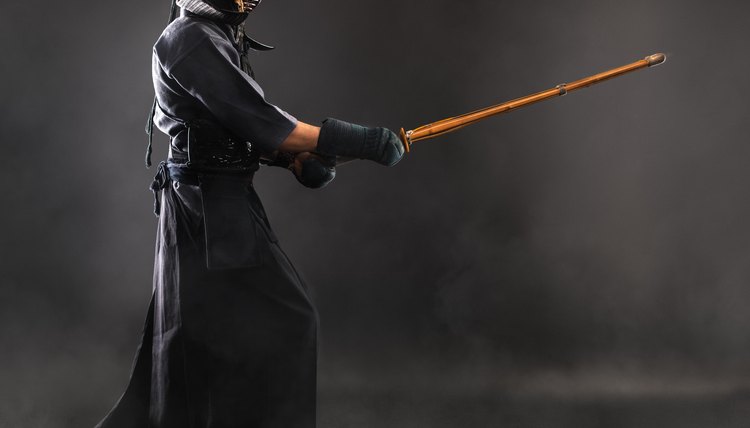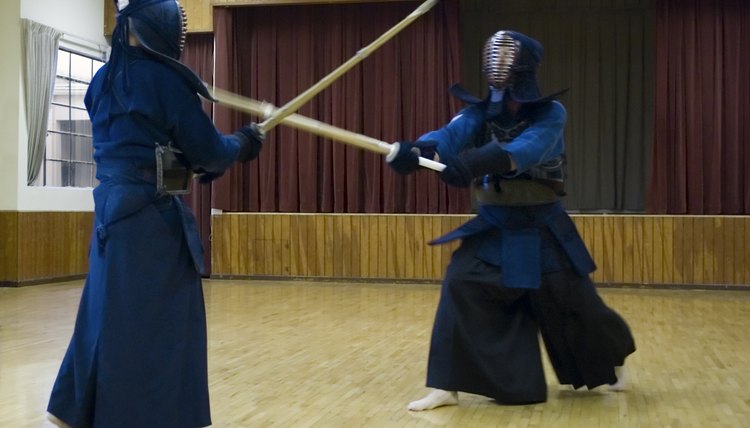How to Learn Kendo at Home

Kendo is a modern Japanese combat sport that pits two opponents against each other while outfitted with bamboo swords and traditional armor, or “bogu.” Owing its origins to the kenjutsu styles of medieval samurai, kendo was adopted as a competitive alternative to the serious sword arts practiced in historical Japan.
Kendo students typically learn the basic techniques and forms, or “kata,” under the live instruction of a dojo and in the company of other students whom they regularly engage in controlled combat simulations. However, the basic fundamentals of kendo remain consistent regardless of skill level or rank, and many students are able to master the basics of the kendo art in the comfort of their own homes.
While Japanese sword arts such as kendo, kenjutsu and iaido can be learned and advanced with practice at home, it may be beneficial to find a regional dojo you can attend at least once a month for corrections to your at-home training material.
Set up a Studio
Establish an at-home studio for your regular kendo training sessions. Place a full-body mirror on a far wall so you are clearly able to see your reflection in the surface. Plug in your laptop or movie player so you can see the screen from your training area in front of the mirror.
Train Daily
Create a daily training regimen that combines basic stretching and strengthening exercises with the “waza,” or techniques, learned in kendo. Stretch out your calves, back and hips by sitting on the floor with both legs stretched out in front of you and reaching forward toward your toes. Perform a split to stretch out your hips and quadriceps muscles by separating your heels as far apart on the floor as possible with your toes resting on the ground.
Complete three to five sets of push-ups and sit-ups with 12 repetitions each. While the bamboo “shinai” sword is relatively light and easy to maneuver, the sport of kendo requires tremendous speed and accuracy that can be very demanding on the arms and core muscle groups.
Perform the basic offensive cut of kendo by gripping your shinai with both hands and positioning your feet in the basic forward stance, with your lead foot 2 to 3 feet in front of your back foot. Raise the shinai directly above your head so the tip of the sword goes directly up and back behind your head. Look at your reflection in the mirror and make sure your arms and elbows are bent evenly. Cut down in a forward swing while watching your reflection in the mirror; make sure the shinai completes the cut in a symmetric fashion straight down your body in a vertical slash as you perform a drill of 50 to 100 basic offensive cuts.
Read more: Which Fighting Style Matches Your Personality?
Add in DVDs
Watch free instructional kendo videos available on websites such as Metafilter or YouTube, or available in DVD form. Play the instructional videos in your at-home training studio as you practice each technique and kata to the exact detail in front of the mirror. Rewind the material as much as you need to in order to make sure you fully comprehend each step of the technique, and practice every part in real time.

How to Learn Kendo at Home
Find a Partner
Recruit a kendo sparring or fighting partner for weekly training sessions in order to utilize your training in live combat. Put on the traditional bogu kendo armor including the face mask, protective gauntlets, hauberk and leg protectors. Set the terms for each individual match with your partner and keep points as desired.
Read more: Kenjutsu Techniques
Writer Bio
Based in the Appalachian Mountains, Brian Connolly is a certified nutritionist and has been writing professionally since 2000. He is a licensed yoga and martial arts instructor whose work regularly appears in “Metabolism,” “Verve” and publications throughout the East Coast. Connolly holds advanced degrees from the University of North Carolina, Asheville and the University of Virginia.
